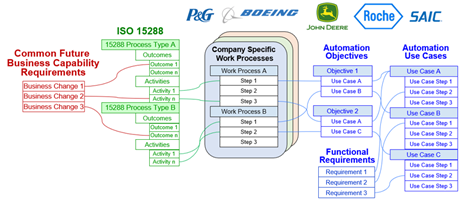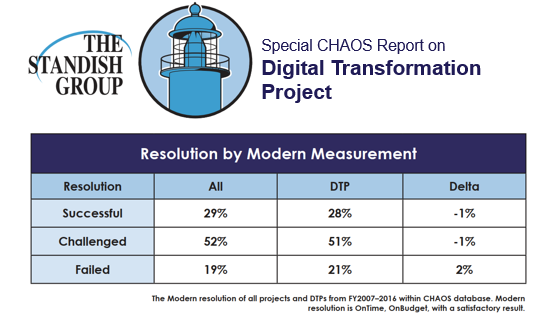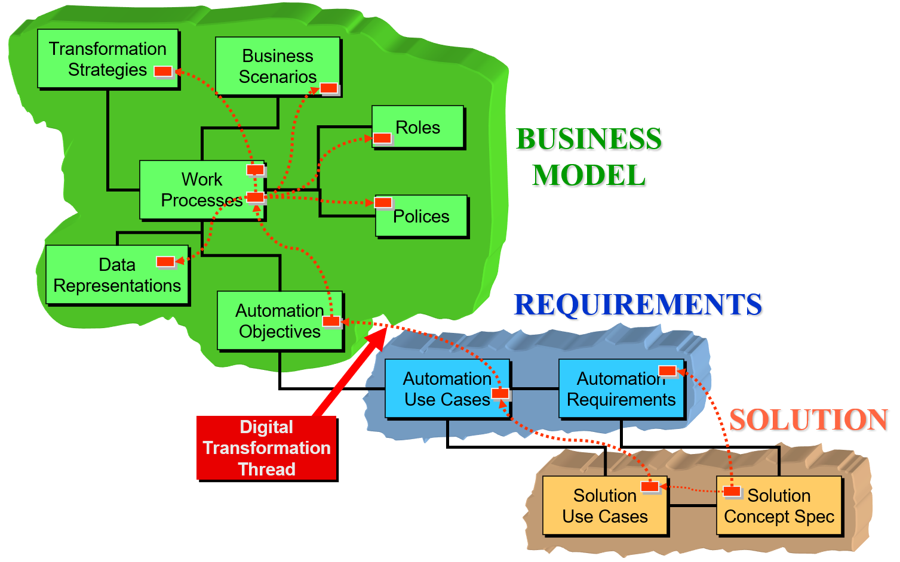business transformation service suite
Occam offers the following specific services to help clients frame, formulate, justify, and execute force-multiplier-scale business transformations.
BUSINESS TRANSFORMATION SERVICES SUITE
Occam offers the following specific services to help clients frame, formulate, justify, and execute force-multiplier-scale business transformations.
Transformation Benchmarking & Masterplanning
CHALLENGE


OCCAM INNOVATION
Occam hypothesized that, if the ISO 15288 framework truly accounts for all the work processes in a system’s life cycle, then it could be used as a Rosetta Stone to enable valuable cross-company knowledge sharing in identifying prospective MBSE benefits and strategies for the realization of the same. To test the hypothesis, Occam:
1) assembled a group of diverse companies (Procter & Gamble, Boeing, John Deere, Roche, SAIC, and Mantech),
2) developed a business transformation metamodel,
3) transformed the ISO 15288 spec into that metamodel and
4) develop supporting automation (on IBM’s DOORS) to support collaborative work within that framework.
Using the framework, 100 common MBSE business transformation objectives were identified, linked to affected system lifecycle processes (for context) and decomposed into automation use cases. Occam continues to work with this group of companies to explicate common automation use cases for the realization of MBSE benefits. Many of the transformation objectives and use case were not previously contemplated by the participants. Thus member companies obtained a more circumspect view of automation requirements from use of the framework.
Reach out to us at Occam if you’re interested in learning more about, or joining, the collaboration.
Enterprise Architecture analysis
CHALLENGE
IT development methods and tools have done much to aid the design and implementation of applications but have done little to improve the practice of designing an IT architecture and subordinating the same to the requirements of the work processes that the architecture is intended to serve.
This is problematic as a typical digital infrastructure of a Fortune 500 company is comprised of hundreds of applications and it is extremely rare to find a Systems Engineering grade, role-based analysis (and visualization) of an IT architecture. And, in the absence of Systems Engineering methods and tools, far too many redundancies are allowed to exist in the enterprise’s organizational and IT architecture, and these redundancies represent investments that could have been directed to create new capabilities.


OCCAM INNOVATION
Occam leverages ASK and Threads methods and tools execute state of the art Model-Based Systems Engineering analysis of the enterprise’s digital architecture. The key benefit of the MBSE analysis is the comprehensive explication of the unique roles required in an enterprise’s digital and organizational architecture. Insights include uncovering overlooked redundant investments, disjointed investments and identifying new strategic architecture requirements.
Digitization Program Requirements Management
CHALLENGE
Today’s typical methods and tools used in Business Process Engineering (BPE) and Digitization Program Requirements Management (DPRM) are not integrated. This is problematic for most Fortune 500 companies because their average product lifecycle requires the execution of hundreds of business processes that span dozens of disciplines that produce hundreds of deliverables. Further, their complex business process frameworks are being “helped” by dozens of digitization projects, running in parallel, delivering hundreds of use cases, that touch hundreds of work process steps and deliverables. Given the size and complexity of the BPE and DPRM arenas, trying to do simultaneous transformations in both, without integrated methods & tools, is often a problematic endeavor. Form more background, search the internet for annual instances of the “Chaos Report” (created by The Standish Group) documenting the extremely high failure rate of digitization projects.


OCCAM INNOVATION
Occam has developed a metamodel and method called the “Business-Driven Application Lifecycle (BDAL)”. BDAL is extremely strong at integrating Business Process Engineering and Digitization process: note, they are indeed different processes that need to be integrated. BDAL accomplished this integration by a Digital Transformation Thread between Stakeholder Needs, Business Process Steps and the individual steps of Automation Use Cases.
Beyond the mission critical task of ensuring digitization serves work processes, the Digital Transformation Thread gives unprecedented control over cost management, progress tracking, risk management and change management. References can be provided (upon request) that will describe the method as innovative, comprehensive, pragmatic, and useful. Further, Occam has leveraged MBSE analysis methods to develop a novel Capability Development organizational model to ensure the sufficiency of staffing business transformations. This service offering service includes training on method and tool (DOORS) along with as-needed client staff augmentation required to pilot the method or to apply the method on customer projects.
transformation governance
CHALLENGE
To achieve Business Transformation, “Digitization” is required but not sufficient. Indeed, over the past three decades there’s but a glut of investments in information technology and yet, no one would claim that their work processes are simpler. In fact, many would agree to the assertion that enterprises are more siloed, and as a result, there is less visibility on how the enterprise fulfills its mission and there is therefor less visibility on how each digitization investment is going to impact the enterprise (both good and bad). To solve this problem, the design of an enterprise’s organization, must address the role of Transformation Governance. To date, most companies are assuming that a single organization, i.e., “IT”, could play this governance role. The “Standish Group’s Chaos Report” chronicles the failures caused by this assumption.


OCCAM INNOVATION
Occam created the Capability Management System (CMS) reference model to enable the continuous improvement of an enterprise’s business transformation capability. The specific performance goal is to achieve a 3x improvement in the rate of business transformation. The key enabling insight provided by the CMS is the recognition that business transformations are delivered by a “business transformation system” that must be managed and improved to execute more effective and efficient business transformations.
To this end, the CMS provides an unobvious yet simple system-of-systems model of the organizational roles that must exist and interact to deliver any business transformation. To be clear, these roles and interactions exist regardless of whether the organization has explicit knowledge of their existence. The idea is to be more explicitly aware of their existence so their efficacy can be tracked and improved.
Click here for an 18-minute recording briefing on this topic.
Transformation Benchmarking & Masterplanning
CHALLENGE


OCCAM INNOVATION
Occam hypothesized that, if the ISO 15288 framework truly accounts for all the work processes in a system’s life cycle, then it could be used as a Rosetta Stone to enable valuable cross-company knowledge sharing in identifying prospective MBSE benefits and strategies for the realization of the same. To test the hypothesis, Occam:
1) assembled a group of diverse companies (Procter & Gamble, Boeing, John Deere, Roche, SAIC, and Mantech),
2) developed a business transformation metamodel,
3) transformed the ISO 15288 spec into that metamodel and
4) develop supporting automation (on IBM’s DOORS) to support collaborative work within that framework.
Using the framework, 100 common MBSE business transformation objectives were identified, linked to affected system lifecycle processes (for context) and decomposed into automation use cases. Occam continues to work with this group of companies to explicate common automation use cases for the realization of MBSE benefits. Many of the transformation objectives and use case were not previously contemplated by the participants. Thus member companies obtained a more circumspect view of automation requirements from use of the framework.
Reach out to us at Occam if you’re interested in learning more about, or joining, the collaboration.
Enterprise Architecture analysis
CHALLENGE
IT development methods and tools have done much to aid the design and implementation of applications but have done little to improve the practice of designing an IT architecture and subordinating the same to the requirements of the work processes that the architecture is intended to serve.
This is problematic as a typical digital infrastructure of a Fortune 500 company is comprised of hundreds of applications and it is extremely rare to find a Systems Engineering grade, role-based analysis (and visualization) of an IT architecture. And, in the absence of Systems Engineering methods and tools, far too many redundancies are allowed to exist in the enterprise’s organizational and IT architecture, and these redundancies represent investments that could have been directed to create new capabilities.


OCCAM INNOVATION
Occam leverages ASK and Threads methods and tools execute state of the art Model-Based Systems Engineering analysis of the enterprise’s digital architecture. The key benefit of the MBSE analysis is the comprehensive explication of the unique roles required in an enterprise’s digital and organizational architecture. Insights include uncovering overlooked redundant investments, disjointed investments and identifying new strategic architecture requirements.
Digitization Program Requirements Management
CHALLENGE
Today’s typical methods and tools used in Business Process Engineering (BPE) and Digitization Program Requirements Management (DPRM) are not integrated. This is problematic for most Fortune 500 companies because their average product lifecycle requires the execution of hundreds of business processes that span dozens of disciplines that produce hundreds of deliverables. Further, their complex business process frameworks are being “helped” by dozens of digitization projects, running in parallel, delivering hundreds of use cases, that touch hundreds of work process steps and deliverables. Given the size and complexity of the BPE and DPRM arenas, trying to do simultaneous transformations in both, without integrated methods & tools, is often a problematic endeavor. Form more background, search the internet for annual instances of the “Chaos Report” (created by The Standish Group) documenting the extremely high failure rate of digitization projects.


OCCAM INNOVATION
Today’s typical methods and tools used in Business Process Engineering (BPE) and Digitization Program Requirements Management (DPRM) are not integrated. This is problematic for most Fortune 500 companies because their average product lifecycle requires the execution of hundreds of business processes that span dozens of disciplines that produce hundreds of deliverables. Further, their complex business process frameworks are being “helped” by dozens of digitization projects, running in parallel, delivering hundreds of use cases, that touch hundreds of work process steps and deliverables. Given the size and complexity of the BPE and DPRM arenas, trying to do simultaneous transformations in both, without integrated methods & tools, is often a problematic endeavor.
For more background, search the internet for annual instances of the “Chaos Report” (created by The Standish Group) documenting the extremely high failure rate of digitization projects.
transformation governance
CHALLENGE
To achieve Business Transformation, “Digitization” is required but not sufficient. Indeed, over the past three decades there’s but a glut of investments in information technology and yet, no one would claim that their work processes are simpler. In fact, many would agree to the assertion that enterprises are more siloed, and as a result, there is less visibility on how the enterprise fulfills its mission and there is therefor less visibility on how each digitization investment is going to impact the enterprise (both good and bad). To solve this problem, the design of an enterprise’s organization, must address the role of Transformation Governance. To date, most companies are assuming that a single organization, i.e., “IT”, could play this governance role. The “Standish Group’s Chaos Report” chronicles the failures caused by this assumption.


OCCAM INNOVATION
Occam has created a Capability Management System (CMS) reference model. The goal of CMS is to enable the establishment of realistic accountability for the various roles and interactions required by business transformations and to enable continuous improvement of an enterprise’s business transformation capabilities. The CMS achieves this objective by first recognizing the phenomena of “business transformation” as a system (in and of itself) that, in order to be improved, must first be recognized. To this end, Occam has applied Model Based Systems Engineering methods to explicate its sub-systems. The sub-systems have been decomposed to the point at which specific sub-system roles can be assigned to personnel in the enterprise pursuing transformation. A key finding is that most transformation sub-system roles must be staffed permanently if an organization is to efficiently accomplish a series of transformations over time.
Watch our briefing on this topic here.
TRANSFORM YOUR BUSINESS WITH OCCAM SYSTEMS
For more information about our service offerings, reach out to our team today.
